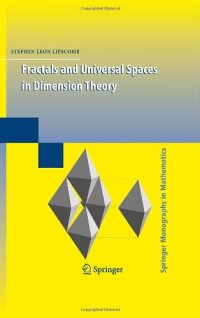
Ebook: Fractals and Universal Spaces in Dimension Theory
Author: Stephen Lipscomb (auth.)
- Genre: Mathematics
- Tags: Topology, Analysis, Functions of a Complex Variable, Dynamical Systems and Ergodic Theory
- Series: Springer Monographs in Mathematics
- Year: 2009
- Publisher: Springer-Verlag New York
- Edition: 1
- Language: English
- pdf
For metric spaces the quest for universal spaces in dimension theory spanned approximately a century of mathematical research. The history breaks naturally into two periods — the classical (separable metric) and the modern (not necessarily separable metric). While the classical theory is now well documented in several books, this is the first book to unify the modern theory (1960 – 2007). Like the classical theory, the modern theory fundamentally involves the unit interval.
By the 1970s, the author of this monograph generalized Cantor’s 1883 construction (identify adjacent-endpoints in Cantor’s set) of the unit interval, obtaining — for any given weight — a one-dimensional metric space that contains rationals and irrationals as counterparts to those in the unit interval.
Following the development of fractal geometry during the 1980s, these new spaces turned out to be the first examples of attractors of infinite iterated function systems — “generalized fractals.” The use of graphics to illustrate the fractal view of these spaces is a unique feature of this monograph. In addition, this book provides historical context for related research that includes imbedding theorems, graph theory, and closed imbeddings.
This monograph will be useful to topologists, to mathematicians working in fractal geometry, and to historians of mathematics. It can also serve as a text for graduate seminars or self-study — the interested reader will find many relevant open problems that will motivate further research into these topics.
Historically, for metric spaces the quest for universal spaces in dimension theory spanned approximately a century of mathematical research. The history breaks naturally into two periods - the classical (separable metric) and the modern (not-necessarily separable metric). The classical theory is now well documented in several books. This monograph is the first book to unify the modern theory from 1960-2007. Like the classical theory, the modern theory fundamentally involves the unit interval. Unique features include:* The use of graphics to illustrate the fractal view of these spaces;* Lucid coverage of a range of topics including point-set topology and mapping theory, fractal geometry, and algebraic topology;* A final chapter contains surveys and provides historical context for related research that includes other imbedding theorems, graph theory, and closed imbeddings;* Each chapter contains a comment section that provides historical context with references that serve as a bridge to the literature. This monograph will be useful to topologists, to mathematicians working in fractal geometry, and to historians of mathematics. Being the first monograph to focus on the connection between generalized fractals and universal spaces in dimension theory, it will be a natural text for graduate seminars or self-study - the interested reader will find many relevant open problems which will create further research into these topics.